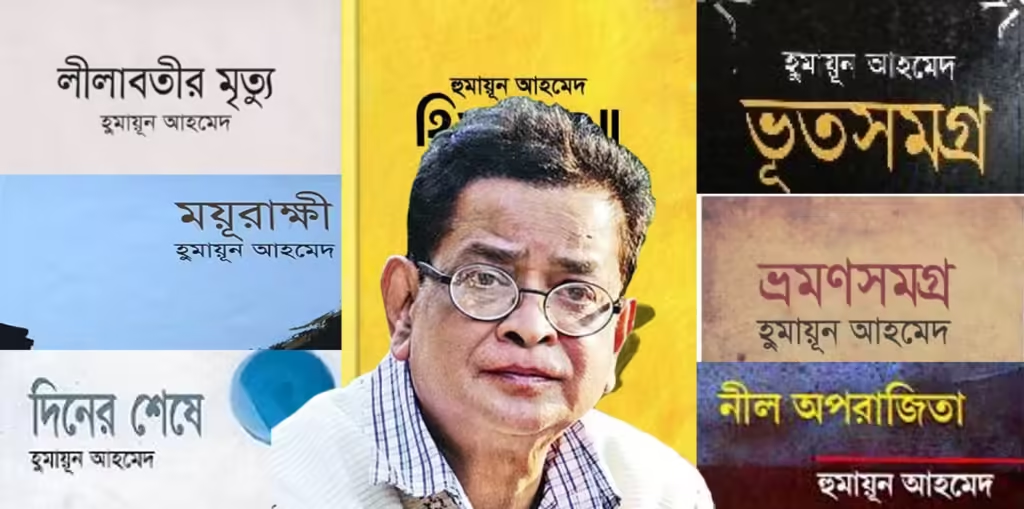
Introduction
Humayun Ahmed was a Bangladeshi novelist, playwright, screenwriter, filmmaker, lyricist, scholar and academic.In this article, we will showcase a short but informative biography of this legend, Humayun Ahmed.
Who is Humayun Ahmed?
Humayun Ahmed was one of the most popular Bengali fiction writers of the 20th century. He is regarded as one of the best and most popular writers of post-independence Bangladesh. He is the father of the new style of dialogue in Bengali fiction. On the other hand he is the pioneer of modern Bengali science fiction. He is also acclaimed as a drama and film director. The number of his published books is more than three hundred.
Birth
Humayun Ahmed was born on 13 November 1948 at his maternal grandfather’s house in Mohanganj, Netrakona subdivision of Mymensingh district in the then East Pakistan (now Bangladesh). His village home is in Kutubpur village of Kendua upazila of Netrokona district. His father Shaheed Faizur Rahman Ahmad and mother Ayesha Faiz. His father was a police officer and he was martyred in 1971 while on duty as the Sub-Divisional Police Officer (SDPO) of the then Pirojpur subdivision during the Bangladesh Liberation War.
Education
Humayun Ahmed got the opportunity to study in different schools of the country as his father stayed in different places of the country due to his job. His institutional education began in 1955 at Kishori Mohan Pathshala (present Kishori Mohan (Boys) Government Primary School), Sylhet. He studied there till 1959. In 1963, he was admitted to Bogra District School in Class IX. In 1965, he passed the matriculation examination from this school and secured second position in the Rajshahi Education Board. He later got admission in Dhaka College and from there passed higher secondary in science department. He studied Chemistry at Dhaka University and obtained first class B.Sc (Honors) and M.Sc.
Worklife
He wrote over 200 fiction and non-fiction books. He was one of the most popular authors and filmmakers in post-independence Bangladesh. Pakistani English newspaper Dawn referred to him as the cultural legend of Bangladesh. In the early 1990s, Humayun Ahmed emerged as a filmmaker.
The Writer Humayun Ahmed
He wrote more than two hundred stories and novels till his death. One of the main characteristics of his works is ‘Golpo-samriddhi’. Besides, he effortlessly and believably portrays surreal events that can be considered as a form of magical reality. His stories and novels are dialogue driven. His descriptions are modest and he has an uncanny talent for portraying characters in just a few sentences. Although not lacking in social consciousness, it is noticeable that political motivation is absent in his works. He never imposed his own opinion on any character. A strong sense of goodwill is active in all the works and he is not biased in characterisation. He shuns character bias and manipulation, resulting in sympathetic portrayal of even ‘negative’ characters in his writings. In this regard, he is influenced by the American writer John Steinbeck. Besides, many of his works reflect his personal experiences and perceptions.
Creations of Humayun Ahmed
He went on to make a total of eight films – each based on his novels. Some of his notable films are: Daruchini Dip, Aguner Poroshmoni, Srabon Megher Din, Shonkhonil Karagar, Dui Duari, Shyamol Chhaya and Ghetuputra Komola.
Awards
Humayun Ahmed was awarded several awards for his numerous multidimensional creations. He won the Writers’ Camp Award in 1973 for his contribution to Bengali fiction. He won the Bangla Academy Award in 1981 for his outstanding contribution to Bengali novels. Besides, he won the Bangladesh Shishu Academy Award. In 1987 he received the Michael Madhusudan Medal. In 1990 he received the Humayun Qadir Memorial Award. Besides, he won the Zainul Abedin gold medal. He won his first National Film Award for Best Narrator for the 1992 film Shankhneel Jail. In 1994, the Government of Bangladesh awarded him Ekushey Padak, the country’s second civilian honor, for his unique contribution to Bengali language and literature. In the same year, he won three National Film Awards for Best Film, Best Story Writer and Best Dialogue Writer for his film Agun Parashmani. He won the Bacchus Award for Best Film, Best Narrator and Best Lyricist for the film Srabon Megher Din (1999). In addition, the film was ranked ninth in the list of the top ten Bangladeshi films by critics in the survey of Sight and Sound magazine. He also has countless other awards.
Death
In the last part of his life, he lived in a flat in Dakhin Hawa Bhawan, built on 3/A Road in Dhanmondi, an elite residential area of Dhaka city. He had a habit of getting up early in the morning, he used to write from dawn till 10-11 am. He felt comfortable sitting on the ground and writing. Sometimes he used to paint when he had free time. In September 2011, he was diagnosed with colon cancer during medical treatment in Singapore. He received treatment at Memorial Sloan-Kettering Cancer Center in New York. However, since the tumor does not spread outside, it is easily treatable initially, but it goes out of control in a short time. He was given 12 rounds of chemotherapy. Although he improved somewhat after the surgery, his condition rapidly deteriorated due to an unknown virus attacking his body at the last moment. He was under treatment for nine months due to rectal cancer. He died on July 19, 2012 at Bellevue Hospital in New York after being put on artificial life support. He was buried in Nuhash Palli.
Conclusion
Although Humayun Ahmed is no longer with us today, his writings are still a gift to people from all walks of life, from teenagers to youths, his contribution to Bengali literature cannot be forgotten.

















